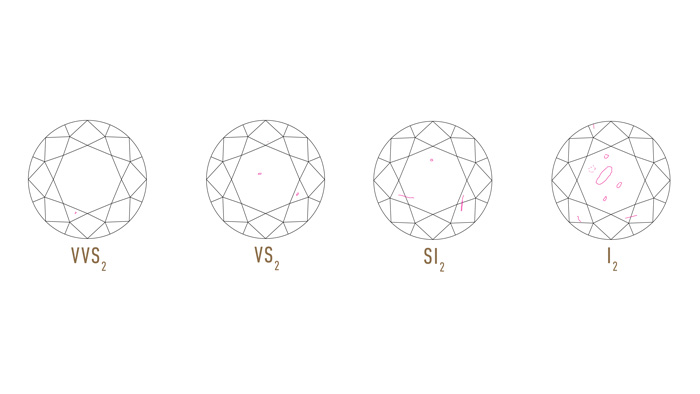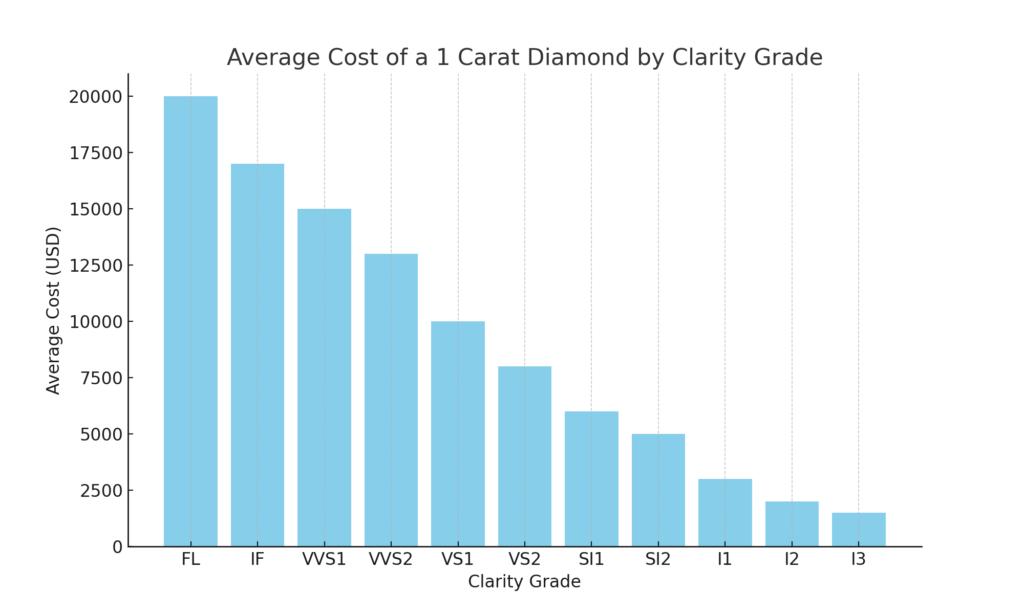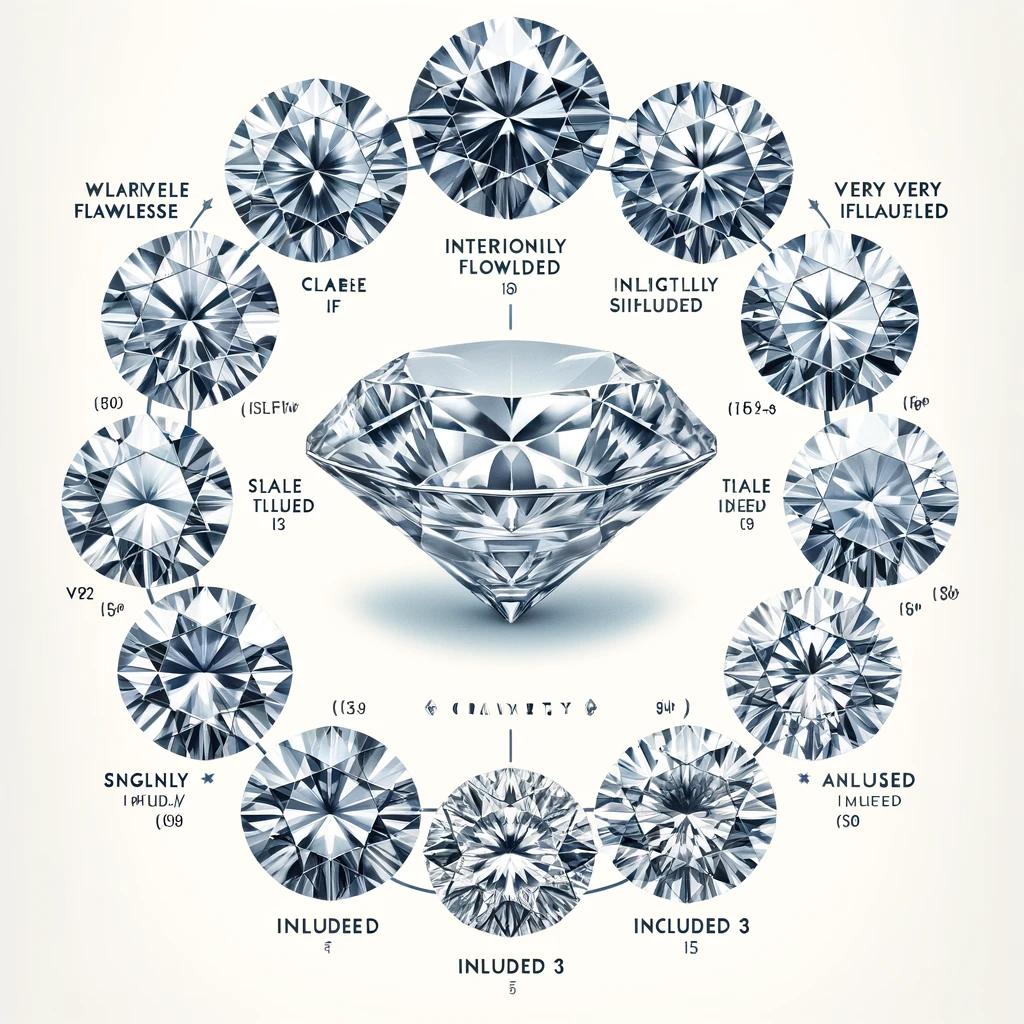Understanding Diamond Clarity: A Comprehensive Guide to Making an Informed Buying Decision
When you’re in the market for a diamond, whether it’s for an engagement ring, a special gift, or a personal treat, the clarity of the diamond is a crucial factor to consider.
This guide will delve into what diamond clarity actually is, explore the different levels of clarity using a clarity chart, discuss which clarity grade might be best for your needs, and compare the importance of clarity versus color.
By understanding these elements, you can make a more informed decision that balances beauty, quality, and cost.
What is Diamond Clarity?
Diamond clarity refers to the absence of inclusions and blemishes in a diamond.
Clarity Characteristics
- Diamond Inclusions: Internal characteristics or imperfections such as fractures or minerals.
- Diamond Blemishes: Surface imperfections such as scratches or nicks.
- Both can occur naturally during the diamond’s formation deep within the Earth.
The clarity of a diamond is assessed under 10x magnification by skilled graders. The fewer the inclusions and blemishes, the higher the clarity grade, which can significantly affect the diamond’s value and beauty.
The Diamond Clarity Chart

The diamond clarity chart was developed by the Gemological Institute of America (GIA) and is a widely accepted standard for diamond clarity grade.
Here’s an overview of the different clarity grades:
- Flawless (FL): No inclusions or blemishes are visible under 10x magnification. A flawless diamond is extremely rare.
- Internally Flawless (IF): No inclusions and only minor blemishes are visible under 10x magnification.
- Very, Very Slightly Included (VVS1 and VVS2): Inclusions are so slight they are difficult for a skilled grader to see under 10x magnification.
- Very Slightly Included (VS1 and VS2): Inclusions are clearly visible under 10x magnification but are characterized as minor.
- Slightly Included (SI1 and SI2): Inclusions are noticeable under 10x magnification.
- Included (I1, I2, I3): Inclusions are obvious under 10x magnification and may affect transparency and brilliance.
When can you see diamond imperfections with the eye?
The level of diamond clarity at which imperfections become visible to the naked eye typically starts at the Si2 clarity (Slightly Included 1). The imperfections become more noticeable in lower grades like Si2 clarity and I1 clarity.
Diamonds graded SI1 may have inclusions that are visible to the naked eye, but this can depend on the nature and location of the inclusions.
Generally, for most people, diamonds graded VS2 (Very Slightly Included 2) and higher are considered “eye-clean,” meaning that their inclusions are not visible to the naked eye under normal viewing conditions.
It’s important to note that individual perception can vary, and factors such as the size of the diamond, the nature of the inclusions, and lighting conditions can influence whether imperfections are visible without magnification.
Which Diamond Clarity is Best?
The best diamond clarity is FL for flawless.
However, the “best” clarity for you depends entirely on your personal preferences and budget.
If you desire a diamond with no visible inclusions to the naked eye, a grade of VS2 or higher is typically sufficient. These diamonds offer a good balance between aesthetic appeal and cost, providing beauty without the premium price of the higher clarity grades.
For those on a stricter budget, diamonds in the SI range can be an excellent choice. They often have inclusions that are not visible without magnification, making them more affordable without compromising the visual quality too much. Diamonds graded I1 might show visible inclusions, affecting the stone’s brilliance, and are usually much cheaper.

Is Color or Clarity More Important?
Deciding whether color or clarity is more important in a diamond is subjective and depends on individual preference and the specific application of the diamond.
Color refers to the degree to which a diamond is colorless. The scale ranges from D (colorless) to Z (light yellow or brown), and colorless diamonds are typically more desirable and expensive.
Color is one of the 4Cs and is a crucial factor to consider when choosing a diamond.
Clarity becomes more critical in higher grades as visible inclusions can detract from the diamond’s beauty. Ultimately, the balance between color and clarity should align with personal preferences and budget, as both contribute to the diamond’s value and appeal.
Diamond Clarity Chart Price

Key Points
Finding the right mix of clarity, cut, carat, and color is crucial for optimal value.
- Diamond clarity refers to the absence of internal inclusions and external blemishes.
- Ranges from Flawless (FL) to Included (I1, I2, I3). Each grade indicates the visibility and impact of imperfections under 10x magnification.
- Imperfections become noticeable to the naked eye at SI2 and lower grades. VS2 and higher grades are generally “eye-clean,” meaning no visible inclusions under normal viewing conditions.
- VS2 or higher is recommended for a balance of beauty and cost.
- SI range offers affordability with minimal visible inclusions; I1 diamonds may show visible imperfections but are more budget-friendly.
